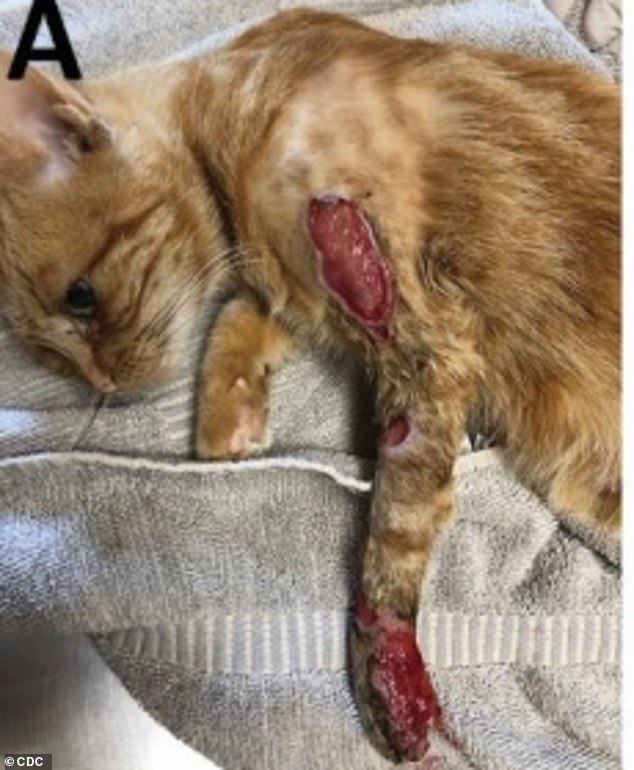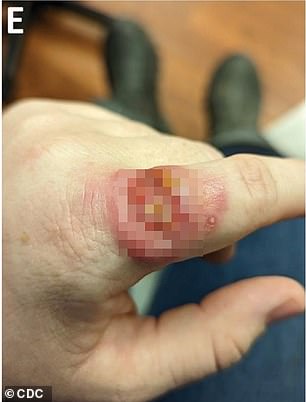Domestic cat passes rare fungal infection to vet tech who is left with gruesome sores: CDC reveals third US case
A Kansas veterinarian has become the third American to contract a rare fungal infection after being scratched by a domestic cat.
She was left with horrific sores all over her arm, and one of the cats had to be put down when the lesions worsened and spread to the other three limbs.
The incident occurred in Kansas, when the cat was brought to the woman’s clinic with a lesion on her paw, and the vet attended to it.
It was the second cat in the area to develop sporotrichosis, officially making this a “cluster” that the CDC wanted to alert other veterinarians about.
She was scratched by the cat through a puncture in her glove and came into direct contact with lesions on the cat’s paws caused by the Sporothrix fungus.
The first cat was humanely euthanized and cremated after failing to improve

The first cat’s lesions progressed and had to be humanely euthanized
This was the third human case in the US, but infections are much more common in South America, where the fungus is more common in soil and on plants.
The specific fungus that caused the lesions, Sporothrix schenckii, is typically found in tropical climates, especially in soil and decaying plants.
It causes sporotrichosis if it comes into contact with breaks in the skin or puncture wounds. In the vet’s case, it initially caused ulcers on her fingers, which if left untreated could have led to tissue death there.
According to the CDC, “Sporotrichosis usually affects the skin or tissues under the skin. The first symptom…is usually a small, painless bump that can develop between 1 and 12 weeks after exposure to the fungus.
‘The bump can be red, pink or purple and usually appears on the finger, hand or arm where the fungus has entered through a break in the skin. The bump will eventually get bigger and may resemble an open sore or sore that heals very slowly.”
The vet’s scratch resulted in an ulcer on her hand two weeks later.
She had to undergo treatment with antifungal medications for eight months before the lesions on her arm healed.
Cat-borne cases of fungal infections due to S. schenckii are rare in the US and the disease is typically caused by a fungus native to Brazil. The number of infections in the US is difficult to diagnose because there is no national surveillance.
Risk factors for cats contracting sporotrichosis are similar to those in humans, including wound contamination with hay, roses, or peat moss, or bites or scratches from other cats.
The incident occurred in 2022 with two cats. The first cat doctors saw was the one that caused the infection at the vet.

The infection caused horrific sores on the vet’s finger and spread up her arm
The cats contracted the disease after fighting. It is more common in cats that spend time outdoors.
The CDC recommends keeping them indoors as much as possible to prevent infection and transmission.
The first cat was humanely euthanized and cremated.
The second cat, brought in by the same owners, turned out to have an infection from the same fungus.
CDC-affiliated researchers wrote: ‘The disease course of cat 1 highlights the potential severity of feline sporotrichosis.
‘Early diagnosis of sporotrichosis and early treatment with appropriate antifungal agents can improve outcomes and help prevent transmission to other cats or people.’
About two weeks after the vet’s glove was punctured, a small blister formed on her hand and the tissue there died.
She started treatment with cephalexin, an antibiotic commonly used to treat skin infections, but was switched to itraconazole, an antifungal, and doxycycline, an antibiotic.
She took those medications for eight months and recovered.
Researchers added: ‘In conclusion, greater awareness of feline sporotrichosis and the potential for zoonotic transmission could help veterinary professionals more quickly recognize and treat feline cases and take precautions to prevent human readmission in the veterinary setting.’
Wounds from scratches or bites from infected cats should be washed immediately, and people who come into contact with them “should seek health care immediately.”
Some people have been known to get sporotrichosis just from touching an infected cat and then touching their eyes. Scratches or bites do not always cause this.
The CDC has warned in the past about the zoonotic spread of sporotrichosis, although the infections have mainly been observed in South America. A March 2023 study showed three known human cases of the disease in Britain for the first time.
The British cases involved a 63-year-old woman, her 30-year-old daughter and a vet in her late 20s. All three people had been in contact with a 9-year-old domestic cat, which the mother and daughter, originally from south-eastern Brazil, had rescued and brought to Britain three years earlier.
The woman, her daughter and the vet’s symptoms – small lesions on their arms or fingers – disappeared completely after treatment with itraconazole.
Sporotrichosis is not usually fatal, but if left untreated it can lead to inflammation throughout the body or infections in the organs. People with weakened immune systems and people with HIV may be at greater risk of developing more serious diseases.
